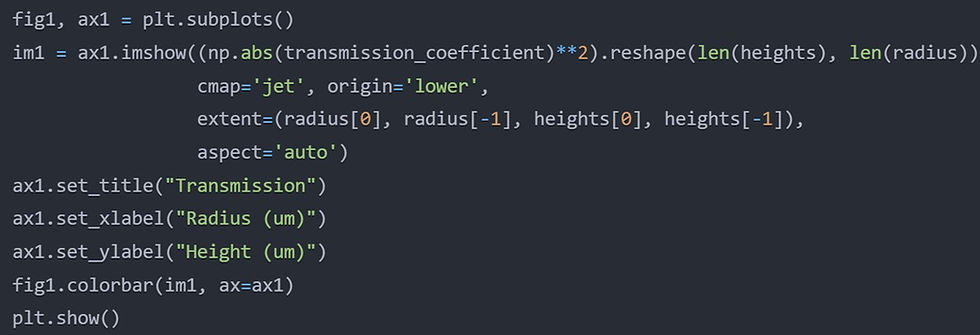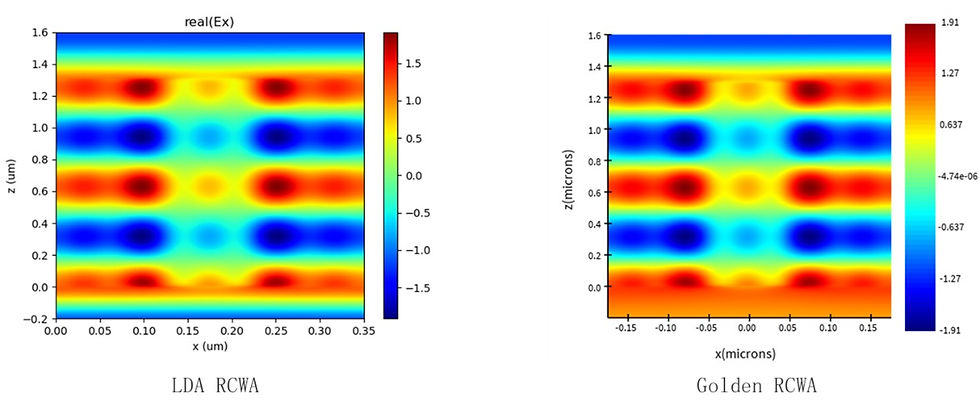A Comprehensive Guide to RCWA Simulation for Optical Structures
- Latitude Design Systems

- Aug 21, 2024
- 3 min read
Introduction
Rigorous Coupled-Wave Analysis (RCWA) is a powerful computational method used in photonics and optics to analyze the interaction of electromagnetic waves with periodic structures. This tutorial will guide you through the process of using RCWA to simulate optical structures, focusing on a cylindrical meta-atom as an example. We'll cover the basic concepts, parameter settings, simulation setup, and result analysis using the Latitude’s RCWA software.
1. Understanding the Basic Structure and Parameters
RCWA simulations typically involve a multi-layer structure. Let's break down the key components:
Region I: Input layer (incident region)
Region II: Output layer (transmission region)
Intermediate layers: These represent the structure being analyzed
Key parameters include:
𝑘⃗inc: Incident wave (plane wave)
θ: Elevation angle of the incident wave
φ: Azimuthal angle of the incident wave
Λx: Lattice constant in the x-direction
Λy: Lattice constant in the y-direction
Note: Layers are numbered from the input layer (-1) upwards (0, 1, 2, ...).
2. Setting Up the Simulation:
To begin, we need to import the necessary modules and set up our simulation environment. Here's a step-by-step guide:
1.Importing Required Modules:

2.Defining Basic Parameters:

3.Setting Up the Mesh:
The mesh is crucial for discretizing our structure. We use the `mesh_setting` function:

This creates a mesh with 350x350 points based on our lattice vectors.
3. Performing Parameter Sweeps:
One of the powerful aspects of RCWA is the ability to perform parameter sweeps to optimize structures. Let's set up a sweep for pillar height and radius:

This creates 51 evenly spaced values for both height (1 to 1.5) and radius (0.05 to 0.15).
4. Running the Simulation:
Now, let's set up our main simulation loop:

This loop iterates over all combinations of height and radius, creating a pillar for each, setting up the RCWA simulation, and calculating the transmission coefficient.
5. Analyzing and Visualizing Results:
After running the simulation, we can analyze and visualize our results:
1.Exporting Data:

This saves our transmission data to a CSV file.
2.Visualizing the Transmission Spectrum:

This creates a 2D color plot of transmission as a function of pillar height and radius.
6. Advanced Analysis: Field Calculations
Beyond transmission spectra, RCWA allows us to calculate electromagnetic fields within our structure. Let's calculate the electric and magnetic fields in the xz-plane:
1.Setting Up the Calculation:

2.Calculating Fields:

This calculates all components of the electric and magnetic fields in the xz-plane at y=0.175.
3.Visualizing Fields:

This creates a 2D color plot of the real part of the Ex field component.


7. Best Practices and Tips:
Mesh Resolution: The accuracy of your simulation depends heavily on the mesh resolution. Always perform a convergence study to ensure your results are reliable.
Fourier Orders: The truncation order in the Fourier expansion affects both accuracy and computation time. Start with lower orders and increase until results converge.
Material Properties: Ensure you're using accurate material properties (dielectric constants) for your wavelength of interest.
Incident Wave: Pay attention to the polarization and angle of your incident wave. These can significantly affect your results.
Periodic Boundaries: Remember that RCWA assumes periodic boundary conditions. Ensure your unit cell is appropriate for your structure.
8. Troubleshooting Common Issues:
Convergence Problems: If your simulation isn't converging, try increasing the Fourier truncation order or mesh resolution.
Unexpected Results: Double-check your unit conversions. All lengths (wavelength, lattice constants, etc.) should be in the same units.
Performance Issues: For large parameter sweeps, consider using parallel processing to speed up calculations.
Field Singularities: Be cautious when interpreting field results near material interfaces, where singularities can occur.
Conclusion
RCWA is a powerful tool for analyzing periodic optical structures. This tutorial has covered the basics of setting up an RCWA simulation, performing parameter sweeps, and calculating field distributions. By following these steps and best practices, you can effectively use RCWA to design and optimize a wide range of optical devices, from metamaterials to diffraction gratings.
Remember that while RCWA is highly accurate for many structures, it has limitations, particularly for highly non-periodic structures or those with very fine features compared to the wavelength. In such cases, other numerical methods like FDTD (Finite-Difference Time-Domain) might be more appropriate.
As you become more familiar with RCWA, you'll be able to tackle more complex structures and extract deeper insights into their optical properties. Happy simulating!




Comments